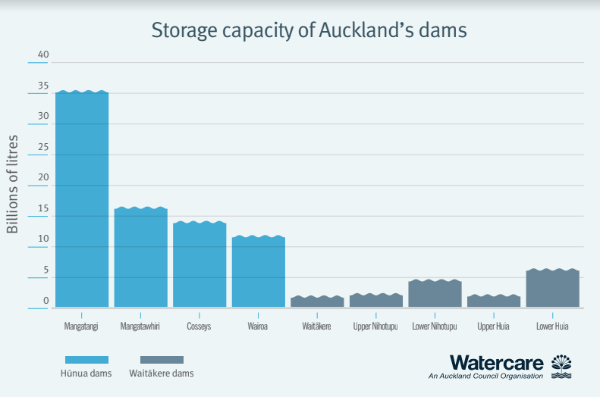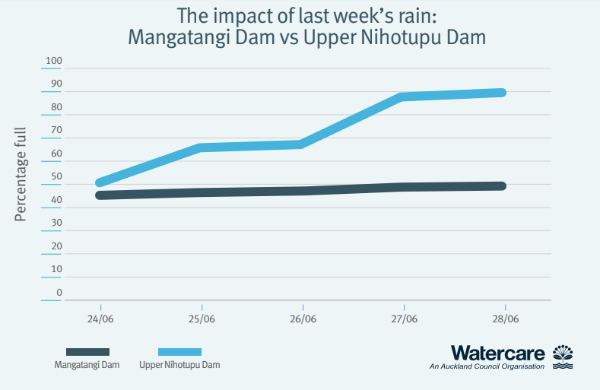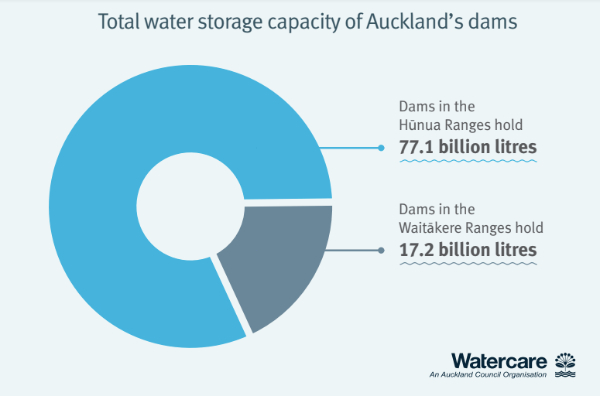Dramatic Rise In Upper Nihotupu Dam Highlights Relative Size Of Each Water Storage Lake

Upper Nihotupu Dam in the Waitākere Ranges has benefited most from the heavy rainfall over the past week, with a storage boost from 51 per cent full on Wednesday morning, to 93 per cent full today.
But significant replenishment in the western dams does not mean we can all abandon our water-saving efforts.
Watercare chief executive Raveen Jaduram says that over the past week, the city’s water storage level has risen from 45 per cent to 55 per cent.
“It’s good to see the dam levels moving in the right direction, but it would be premature to celebrate now. We have to remember, the historical average for this time of year is 79.8 per cent – and we’re still a long way from there.”
Jaduram says further rainfall over the course of the week will bump up the total water storage level but its overall impact will depend on where the rain lands.
“We really need the rain to fall in the Hūnua Ranges,” he says. “This is because the dams in this area are much larger than our dams in the Waitākere Ranges, and it takes significantly more rainfall to fill them back up after a period of dry weather.

“To put this in context, all of the water in our five western dams, when full, would only half fill Mangatangi Dam in the Hūnua Ranges.”
The Hūnua dams provide 82 percent of Auckland’s total water storage. Typically, they receive enough rain to recharge once over the course of a year, whereas our smaller Waitākere dams may recharge five times. This means our Waitākere dams can be very full, or even spilling, when our Hūnua dams are still low.
While Upper Nihotupu Dam went from 51 per cent full to 91 per cent full from June 24 to June 29, Mangatangi Dam’s water level rose from 45 per cent to 50 per cent over the same period.
Jaduram says Watercare is operating the water supply system to ensure as little water as possible is spilled.
“When Upper Nihotupu Dam spills, the water is not lost – it goes into Lower Nihotupu Dam. This is why we are currently maximising our intake from Lower Nihotupu Dam.”
Our ability to utilise the water stored in our western dams is limited by the production capacity of the Huia Water Treatment Plant. The plant is nearly 100 years old and reaching the end of its operational life.

Planning is underway to replace this treatment plant and to increase the volume of treated water stored locally. The new plant will be able to produce up to 140 million litres of water a day – which is 30 million litres more than the sustainable output of the existing plant. Resource consent has been lodged and an Auckland Council hearing will readjourn later this year.
Jaduram says while our total dam storage is now more than half full and we can expect normal winter rainfall in July, outdoor water restrictions will continue and all Aucklanders are still urged to save water.
“We still need a lot of rain to fill up our dams, and the outlook is for a very dry second half of 2020, particularly between August and November. We need to be in the best possible position at the start of summer, so please keep doing your bit to reduce your water usage. Aucklanders have done a fantastic job so far, and we need to keep up the good habits we’ve adopted during the drought.”


 Gordon Campbell: On The History Of Doo Wop Music
Gordon Campbell: On The History Of Doo Wop Music NZ Government: Strong Biosecurity More Important Than Ever
NZ Government: Strong Biosecurity More Important Than Ever Environmental Defence Society: Regulatory Standards Bill Should Be Stopped In Its Tracks
Environmental Defence Society: Regulatory Standards Bill Should Be Stopped In Its Tracks NZ Police: A Minute's Silence And Livestream Of Funeral Service For Senior Sergeant Lyn Fleming
NZ Police: A Minute's Silence And Livestream Of Funeral Service For Senior Sergeant Lyn Fleming Socialist Equality Group: Foreign Interference Bill Prepares New Attacks On Democratic Rights
Socialist Equality Group: Foreign Interference Bill Prepares New Attacks On Democratic Rights Melanie Nelson: Act Now On The Proposed Regulatory Standards Bill
Melanie Nelson: Act Now On The Proposed Regulatory Standards Bill Climate Justice Taranaki: The Bill For Individualism, Corporations And Neoliberalism
Climate Justice Taranaki: The Bill For Individualism, Corporations And Neoliberalism


